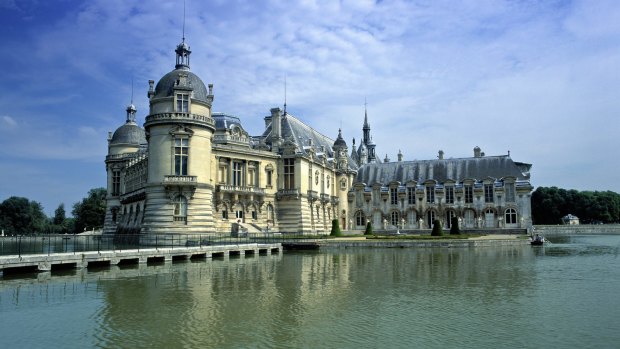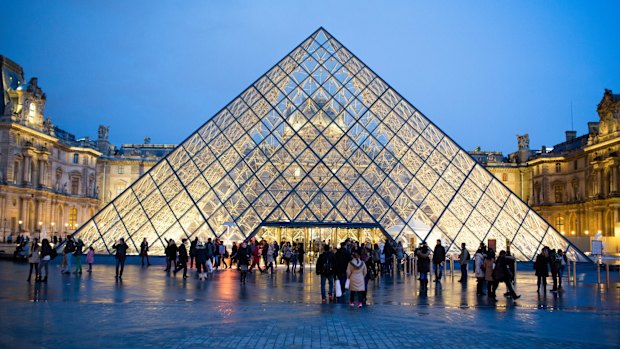This was published 7 years ago
Chantilly, France: What happens on the last leg of Tour de France, Megeve to Paris

Chateau de Chantilly, Chantilly. TDF23Credit: Getty Images
MEGEVE TO PARIS (STAGES 20-21)
The penultimate day of Le Tour is the final alpine section, and is set to decide the recipient of this year's polka-dot jersey (an honour bestowed on the "King of the Mountains", the rider with the most overall points for cresting the route's devilish climbs).
Connecting the pretty resorts of Megeve and Morzine, the stage features a glut of strength-sapping mountain passes and hairpin bends followed by a 12 kilometre downhill finish into a market town stocked with ample choices for a celebratory meal. You might fancy fine-dining like a monarch in Morzine's Michelin-feted eateries (savouring creative affairs like lobster ravioli flavoured with ginger), or cosying up in rustic chalet restaurants, cooking cheese, meat and vegetables on a pierrade (hot stone grill), while clinking glasses of Savoie Chasselas, a fresh, light white tipple cultivated in the nearby wineries by Lac Leman (as the French call Lake Geneva).

The Lourve.Credit: Getty Images
On top of vineyard visits and lake cruises, you can tour the pungent local fruitieres (cheese dairies) that produce the likes of Abondance, Tomme de Savoie and Beaufort Emmental (whose largest wheels, at 70 kilograms, weigh as much as the average Tour competitor). Morzine's outskirts, all wooded slopes and wildflower-matted valleys, are ripe for summer hiking and mountain biking. You can also go caving in misty, mineral-laden tunnels and play golf on some of the Alps' most scenic 18-hole courses.
The last stage of the Tour starts in Chantilly, 650 kilometres north of Morzine (riders are expected to put their feet up and make the trip by car, bus, train or plane). Chantilly is a lovely, leafy town synonymous with its whipped cream - a sweet, mousse-like fix that proved exceedingly fashionable with the tea-partying aristocrats of 18th century Europe. Made with unpasteurised cream, mixed with icing and vanilla sugars, and usually served with luscious berries or cakes, creme de Chantilly is enjoyed in the town's cafes and tearooms, as well as La Capitainerie, the restaurant tucked inside Chantilly's beautiful chateau. Work off the cream by roaming the regal, art-filled suites of this richly-furnished palace, which dates back to Renaissance times, but was heavily rebuilt after suffering extensive damage during the French Revolution. Afterwards, potter around the chateau's entrancing, lake-filled gardens and in its neighbouring forest, a former royal hunting lodge marked with hiking and horse-riding trails. Equine lovers are rather fond of Chantilly. Home to one of France's most esteemed thoroughbred race courses and training centres, it also boasts the sumptuous Great Stables, which were built in the early 1700s on the orders of Louis-Henri, the Duke of Bourbon, who apparently believed he would be reincarnated as a horse and wanted a suitably upscale residence for the next life. Equestrian shows are held at the stables and you can also pop into the Museum of the Horse, which celebrates the relationship between man and horse since the beginning of civilisation.
Leaving Chantilly, many of the saddle-sore Tour riders will no doubt be pondering their relationship with their bicycles as they embark on the final 113 kilometres of this marathon, three-week, 3519 kilometre journey. Mercifully, apart from a few short climbs and mild undulations, stage 21 is pretty crepe-flat, coursing south via the verdant landscapes of Picardy and Ile-de-France, past notable sights such as the Abbey of Royaumont (a 13th century Cistercian abbey that later became a cotton mill, convent and refuge for artists and intellectuals).
Entering Paris' metropolitan sprawl, the race rushes through Argenteuil, a suburb by the River Seine that made a big impression on painters Monet, Monet and Renoir; and Courbevoie, which edges La Defense, a financial district festooned with eye-catching modern skyscrapers. Spectators will have ample opportunity to snap blurring pictures of the peloton (main bunch of riders), as the Tour concludes with an eight-lap circuit of central Paris. It'll zip past iconic landmarks like Arc de Triomphe, Le Louvre and Place de la Concorde - a monumental square sporting a 3300-year-old Egyptian obelisk - before one last, lung-busting sprint finish along Champs-Elysees. Expect a cocktail of emotions as the Tour winner takes to the podium in the prestigious yellow jersey to shower himself - and every one around him - in bubbly. When you tire of the Champs-Elysees crowds, delve down the side streets radiating off this pulsating boulevard for some of the most enduring ingredients of Parisian life (think: the smell of freshly-baked bread wafting from boulangeries, and animated French chatter drifting from pavement cafes and bistros).
Sign up for the Traveller Deals newsletter
Get exclusive travel deals delivered straight to your inbox. Sign up now.